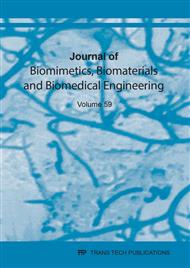[1]
S. I. Correia, H. Pereira,J. Silva-Correia, C.N. Van Dijk, J. Espregueira-Mendes, J. M. Oliveira, and R. L. Reis, Current concepts: tissue Engineering and regenerative medicine applications in the ankle joinc , journal of the royal society interface, 11(2014) 20130784.
DOI: 10.1098/rsif.2013.0784
Google Scholar
[2]
C. Pagano, L. Rebaioli1, F. Baldi), and Irene Fassi, Mechanical Behavior of Scaffold-Like Structures: Research of Relationships between Properties and Geometry, AIP Conference Proceedings (2020), https://doi.org/10.1063/1.5142979.
DOI: 10.1063/1.5142979
Google Scholar
[3]
N. Chantarapanich, P. Puttawibul, S. Sucharitpwatsku, P. Jeamwatthanachai,S. Inglam, and K. Sitthiseripratip , Scaffold library for tissue Engineering a geometric evaluation, Computational and Mathematical Methods in Medicine, (2012)14,https://doi.org/10.1155/2012/407805.
DOI: 10.1155/2012/407805
Google Scholar
[4]
O. Janouskov, Synthetic Polymer Scaffolds for Soft Tissue Engineering, Physiol. Res. 67 (2018) 335-348.
Google Scholar
[5]
M. Mazlama , N. Kamalaldinb , Q. Onga , B. Yahyab and A. Nurazreen, Effect of alginate on the properties of hydroxyapatite scaffold and cell migration assay study, Materials Today: Proceedings, 17 (2019) 820–828.
DOI: 10.1016/j.matpr.2019.06.368
Google Scholar
[6]
F. Donnaloja , E.Jacchetti , M. Soncini and M. Raimondi, Natural and Synthetic Polymers for Bone Scaffolds Optimization, Polymers,12 (2020) 905.
DOI: 10.3390/polym12040905
Google Scholar
[7]
S. Mohammadi, S. Ramakrishna, S. Laurent, M. Shokrgozar, D. Semnani, D.Sadeghi, Sh.Bonakdar, M. Akbari, Fabrication of Nanofibrous PVA/Alginate-Sulfate Substrates for Growth Factor Delivery, Society for Biomaterials, (2018),.
DOI: 10.1002/jbm.a.36552
Google Scholar
[8]
S. Barbon, M. Contran, E. Stocco, S. Todros, V. Macchi, R. De Caro and A. Porzionato, Enhanced Biomechanical Properties of Polyvinyl Alcohol-Based Hybrid Scaffolds for Cartilage Tissue Engineering, Processes 9(2021)730.
DOI: 10.3390/pr9050730
Google Scholar
[9]
Y. Chen, J. Song, S. Wang,and W. Liu, PVA-Based Hydrogels: Promising Candidates for Articular Cartilage Repair, Macromol. Biosci. (2021) 2100147.
DOI: 10.1002/mabi.202100147
Google Scholar
[10]
Sh. Purohit, R. Bhaskar, H. Singh, I. Yadav, M. Gupta, N. Mishra ,Development of a nanocomposite scaffold of gelatin–alginate–graphene oxide for bone tissue engineering,.Int. J. Bio. Macromol. 133(2019) 592–602.
DOI: 10.1016/j.ijbiomac.2019.04.113
Google Scholar
[11]
A. Kumar, K. Rao, S. Han, Mechanically viscoelastic nanoreinforced hybrid hydrogels composed of polyacrylamide, sodium carboxymethylcellulose, graphene oxide, and cellulose nanocrystals. Carbohydr. Polymer. 193 (2018)228–238.
DOI: 10.1016/j.carbpol.2018.04.004
Google Scholar
[12]
Z. Hu, P. Hong, M. Liao, S. Kong, N. Huang, Ch. Ou, S. Li, Preparation and Characterization of Chitosan-Agarose Composite Films, Materials,9(2016)816.
[13]Sh. Chen, Y. Hao, W. Cui, J. Chang, Y. Zhou, Biodegradable electrospun PLLA/chitosan membrane as guided tissue regeneration membrane for treating periodontitis, J Mater Sci, 48 (2013) 6567–6577.
DOI: 10.1007/s10853-013-7453-z
Google Scholar
[14]
M.S.M. Eldin, E.A. Kamoun, E.S. Kenawy, T.M. Tamer, M.A. El-meligy, Poly vinyl alcohol) -alginate physically crosslinked hydrogel membranes for wound, Arab. J. Chem. 1 (2013) 38–47.
DOI: 10.1016/j.arabjc.2013.12.003
Google Scholar
[15]
S. Cesur, F. Nuzhet Oktar, N. Ekren, O. Kilic, D. Bilgic Alkaya, S. Seyhan, Z. Ruya Ege, Ch. Lin, S. Kuruca, G. Erdemir, O. Gunduz, Preparation and characterization of electrospun polylactic acid/sodium alginate/orange oyster shell composite nanofiber for biomedical application, Journal of the Australian Ceramic Society, (2019), 10.1007/s41779-019-00363-1.
DOI: 10.1007/s41779-019-00363-1
Google Scholar
[16]
K.T. Shalumon, K.H. Anulekha, Sreeja V. Nair, S.V. Nair , K.P. Chennazhi, R. Jayakumar, Sodium alginate/poly(vinyl alcohol)/nano ZnO composite nanofibers for antibacterial wound dressings, International Journal of Biological Macromolecules, 49 (2011) 247–254.
DOI: 10.1016/j.ijbiomac.2011.04.005
Google Scholar
[17]
H. Zheng, J. Yang,S. Han,The synthesis and characteristics of sodium alginate/graphene oxide composite films crosslinked with multivalent cations, J. Appl. Polym. Sci. 133(2016) 43616.
DOI: 10.1002/app.43616
Google Scholar
[18]
A. Serrano-Aroca , L. Deb ,Green synthetic routes to alginate-graphene oxide composite hydrogels with enhanced physical properties for bioengineering applications, Eur. Polym. J. 103(2018) 198–206.
DOI: 10.1016/j.eurpolymj.2018.04.015
Google Scholar
[19]
Sh. Bibi, S. Mir, W. Rehman , F. Menaa , A. Gul , F. Alaryani , Al. Alqahtani , S. Haq and M. Abdellatif ,Synthesis and In Vitro/Ex Vivo Characterizations of Ceftriaxone-Loaded Sodium Alginate/poly(vinyl alcohol) Clay Reinforced Nanocomposites: Possible Applications in Wound Healing, Materials 15(2022) 3885.
DOI: 10.3390/ma15113885
Google Scholar
[20]
Ch. Kim, M. Khil, H. Kim, H. Lee, K. Jahng, An improved hydrophilicity via electrospinning for enhanced cell attachment and proliferation, J. Biomed. Mater. Res. - Part B Appl. Biomater. 78(2006) 283–290.
DOI: 10.1002/jbm.b.30484
Google Scholar
[21]
A. Firoozabady , A. Aidun , R. Kowsari-Esfahan , A. Allahyari , Characterization and Evaluation of Graphene Oxide Incorporated into Nanofibrous Scaffold for Bone Tissue Engineering, Journal of Tissues and Materials, 1(2019)1-13.
Google Scholar
[22]
M. Fan, M. Gong, L. Da, L. Bai, X. Chen, J. Li-Ling, Z.Yang, H. Xie, Tissue engineered esophagus scaffold constructed with porcine small intestinal submucosa and synthetic polymers, Biomed. Mater. 9 (2014).
DOI: 10.1088/1748-6041/9/1/015012
Google Scholar
[23]
Sh. Purohit, R. Bhaskar, H. Singh, I. Yadav, M. Gupta, N. Mishra, Development of a nanocomposite scaffold of gelatin–alginate–graphene oxide for bone tissue engineering ,International Journal of Biological Macromolecules, 2019, https://doi.org/10.1016/j.ijbiomac.2019.04.113.
DOI: 10.1016/j.ijbiomac.2019.04.113
Google Scholar
[24]
I.A. Kadhim, Biocompatibility of Alginate-Graphene Oxide Film for Tissue Engineering Applications, Key Engineering Materials,900(2021).
DOI: 10.4028/www.scientific.net/kem.900.26
Google Scholar


